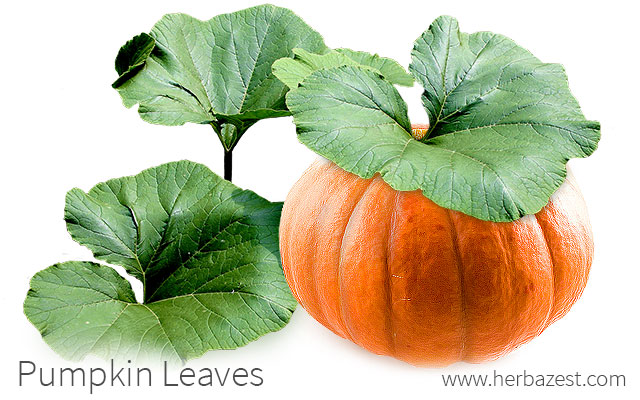Equipped with essential nutrients, various parts of a pumpkin plant combine to form an extremely beneficial crop for human consumption. The dark green leaves of a pumpkin are among its most important components. Pumpkin leaves are harvested, cooked as vegetables, and used for a variety of medicinal and therapeutic purposes.
Pumpkin Leaves' Appearance
Pumpkin leaves are large, round, and deeply lobed. They are alternately arranged, and typically have more than three or more veins originating from the same point. While light green, yellow, and grayish-green varieties are possible, they tend to be dark green in color.
In addition, pumpkin leaves sometimes have serrated edges and may contain fine, glass-like prickles, depending on the variety of pumpkin. In some instances, mottled or spotted patterns can genetically occur.
Harvesting Pumpkin Leaves
Pumpkins are annual plants that grow in warm weather. Using pruning shears or scissors to make a clean cut from the vine, pumpkin leaves can be harvested year round in warm climatesor during the summer and early fall in temperate areas.
How to Preserve and Store Pumpkin Leaves
Fresh pumpkin leaves will start to decrease in quality and nutritional value almost immediately after harvest. However, they can be frozen and stored for up to three or four weeks in plastic freezer bags by separating each row with paper towels.
Additionally, it is a popular custom to sun dry pumpkin leaves for later medicinal and culinary use throughout many regions of Africaparticularly South Africa, where the dried leaves are harvested and packaged with the pumpkin's flowers for added decoration.
First chop the leaves and place them in hot water for three or four minutes to preserve their deep color. Then drain the pumpkin leaves and arrange them on a raised drying rack in direct sunlight, covering with light mesh netting to protect from outside pests. Oven drying is also permissible.
Preparations with Pumpkin Leaves
Always remember to devein pumpkin leaves before use in them the following preparations:
Medicinal Preparations
Decoction. Boil leaves in hot water over medium heat for half an hour. Consume the warmed liquid twice daily. This preparation is used for reducing fever and treating intestinal parasites.
Facial mask. In a food processor, blend pumpkin leaves and a small amount of coconut oil. Add honey to the newly-formed paste and apply directly to the face and neck before rinsing in warm water. This preparation is used to treat skin conditions, like acne.
Culinary preparations
Salads. A good source of iron, pumpkin leaves are comparable to other dark green, leafy veggies like spinach, collard greens, and kale. The fresh leaves cooked or consumed raw in a number of healthy salads
Smoothies. For an added energy boost, blend fresh pumpkin leaves into delicious fruit and vegetable breakfast smoothies.
Soups. Pumpkin leaves can be added to a number of hearty soup recipes. For best results, prepare the pumpkin leaves with beans and healthy oils and fats.
Pumpkin leaves are an important part of the pumpkin plant, and have long been used in traditional medicine to cure common ailments. Additionally, pumpkin leaves can be prepared in a variety of delicious veggie recipes to complement a well-balanced, nutritional diet. They can be harvested or purchased from select ethnic markets and wholesale vendors.
Sources
- Journal of Health, Population and Nutrition, Multiple antibiotic-resistant bacteria on fluted pumpkin leaves, a herb of therapeutic value, 2014
- Missouri Botanical Garden, Horticulture Questions and Answers
- Neglected Crops: 1492 from a Different Perspective, Cucurbits, pp. 63-77
- Nutrition Research Reviews, Medicinal and biological potential of pumpkin: an updated review, 2010
- University of California, Cucurbitaceae - Fruits for peons, pilgrims, and pharaohs
- University of Illinois, Extension Office, Pumpkins and More
- USDA Nutrient Database
- Kew Royal Botanic Gardens, Cucurbita pepo (pumpkin)




